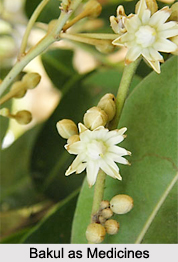 Bakul is an ornamental tree generally reared in gardens for the sake of its fragrant flowers from which distilled water is prepared. Botanically named as Mimusops Elengi is an evergreen tree with sweet scented flowers and it is often grown as garden tree. It is a medicinal tree with edible parts. The ripe fruits are sweetish and edible.
Bakul is an ornamental tree generally reared in gardens for the sake of its fragrant flowers from which distilled water is prepared. Botanically named as Mimusops Elengi is an evergreen tree with sweet scented flowers and it is often grown as garden tree. It is a medicinal tree with edible parts. The ripe fruits are sweetish and edible.
Health Benefits of Bakul
Bakul tree is especially useful in treating gum problems and dental disorders such as bleeding gums, loose teeth, sensitive teeth, cavities etc. The unripe fruits are astringent and are recommended to be chewed for the purpose of fixing loose teeth. Its tender parts are used as tooth brush. The bark and seed coat are used for strengthening the gum. Its fruits are eaten raw and also prepared as pickle. The bark of tree is used to improve fertility in women. The fruits are edible and used to treat chronic dysentery.
Dose of Bakul in Medicine
It is used under the name of "Vajradanti", in preparation of various herbal tooth powders along with many other ingredients such as catechu, pomegranate bark etc. The bark is described as astringent. A decoction of the bark is used as a gargle in diseases of the gums and teeth.
This article is a stub. You can enrich by adding more information to it. Send your Write Up to content@indianetzone.com
Related Articles
Ayurveda
Ayurveda Medication
Elements of Ayurveda
Concepts of Ayurveda
Ancient Literature of Ayurveda
Sushruta Samhita
Classification of Medicine




















